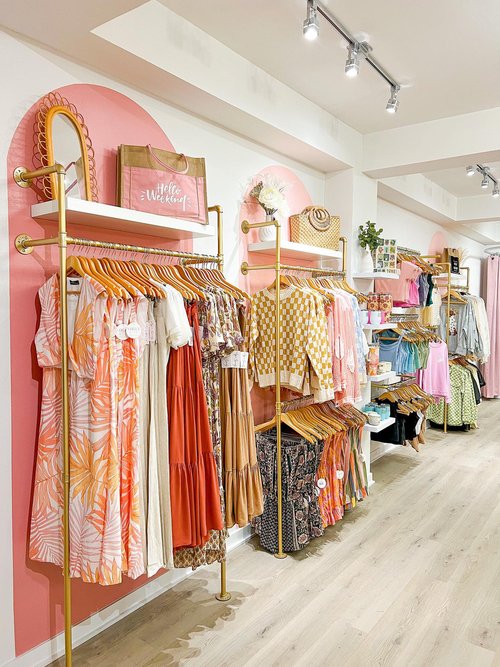Exactly how to Style Your Outfits with Boutique Fashion Discovers
Exactly how to Style Your Outfits with Boutique Fashion Discovers
Blog Article
Exploring the Evolution and Impact of Apparel on Modern Style Trends
The development of clothes has substantially affected modern style trends, merging historic precedents with advanced advancements. Famous figures like Coco Chanel and Yves Saint Laurent changed the style industry by presenting principles that focus on convenience and availability, which proceed to reverberate today.
Historic Style Influencers
In the tapestry of style history, certain figures have actually left an indelible mark, shaping the trends and designs that specify entire eras. Coco Chanel, an advanced designer, redefined women's fashion by introducing comfy, elegant clothes that departed from restrictive corsets.
Elsa Schiaparelli is an additional critical figure, renowned for her progressive designs that incorporated surrealist art, working together with Salvador Dalí to produce whimsical pieces that tested traditional aesthetics. Her ingenious use of shade and bold patterns reverberates in modern fashion. Yves Saint Laurent, on the other hand, equalized haute couture with prêt-à-porter collections, bringing path designs to the masses and establishing a precedent for contemporary ready-to-wear lines.
These enthusiasts, amongst others, not only changed fashion in their times however also set enduring fads that resonate in today's fashion business, supplying a structure upon which contemporary designers remain to construct and introduce. Their heritages underscore the significance of imagination and daring in fashion's ever-evolving story.
Technological Improvements in Style
Amidst the vibrant landscape of the garment industry, technological improvements stand at the forefront of technology, reshaping just how designers develop and customers engage with style. The combination of 3D printing has actually transformed design processes, enabling designers to try out intricate frameworks and lasting products that were previously inconceivable. This technology helps with rapid prototyping, lowering waste and quickening production times.

Smart fabrics, embedding modern technology into textiles, are likewise changing the market. Innovations like temperature-regulating and self-cleaning materials supply boosted performance and comfort. Wearable technology, including functions like fitness tracking and communication, adds a brand-new dimension to fashion, combining aesthetics with usefulness.
Cultural Changes and Style
As technical innovations continue to reshape the fashion business, cultural changes are similarly influential, redefining style and customer preferences. Over the last few years, the increase of social networks platforms has accelerated the circulation of international style trends, allowing varied cultural influences to exist side-by-side and assemble. This electronic interconnectivity has promoted the fast exchange of ideas, bring about an extra diverse and inclusive analysis of design that shows the multifaceted nature of modern culture.
Cultural understanding and gratitude have motivated designers to draw ideas from a broader range of historic and ethnic contexts, integrating typical themes with modern appearances. This fusion has resulted in style that reverberates with a broader target market, promoting a sense of identity and belonging throughout different demographics. Furthermore, the increasing need for customization has driven brands to supply customizable choices, enabling consumers to express uniqueness while showing their cultural heritage.
Additionally, changing societal worths have influenced fashion, with inclusivity and variety ending up being central motifs. The sector has begun to accept versions and influencers of different physique, ethnicities, and sex identifications, challenging traditional beauty criteria. This transformation highlights the power of cultural changes in shaping the future of fashion, as design becomes a more authentic expression of collective and personal identity.
Sustainability and Modern Layout
While the fashion market proceeds to i thought about this evolve, the crucial for sustainability has actually come to be significantly urgent, affecting modern-day layout methods. The surge of slow fashion, which emphasizes quality over quantity, encourages customers to invest in classic pieces instead than transient patterns.
Furthermore, modern layout is identified by its technology in decreasing waste and promoting circularity. Strategies such as zero-waste pattern cutting and 3D knitting are gaining grip, enabling developers to develop garments with marginal fabric wastefulness. In addition, brands are adopting clear supply chains, ensuring liability and cultivating customer trust. This approach not just alleviates ecological influence yet likewise enhances the social responsibility of fashion houses.

Future Trends in Style

Sustainability will certainly remain to be a driving pressure in forming future fashion fads. The market is significantly embracing environmentally friendly materials and moral production techniques, replying to a growing consumer demand for liable practices. Developments such as bio-fabricated materials and closed-loop recycling systems are readied to redefine exactly how clothes is generated and consumed, lowering environmental influence while keeping design and top quality.
Social changes, consisting of the increase of inclusivity and diversity, will certainly also play a pivotal function. As culture becomes much more knowledgeable about social concerns, style is anticipated to come to be a my blog platform for expression and modification. Developers will likely concentrate on developing collections that show a broader series of identifications and experiences, promoting depiction and availability.
Final Thought
The evolution of clothes dramatically influences modern style trends, where historic impacts merge with modern designs. Trick figures like Coco Chanel and Yves Saint Laurent have redefined style, while technological technologies such as 3D printing and smart textiles broaden creative possibilities. Cultural shifts in the direction of inclusivity and sustainability urge brand names to take on ethical methods and accept variety. This ongoing evolution emphasizes style's function as a mirror to social worths and technological innovation, suggesting a future abundant with advancement and inclusivity.
The development of apparel has substantially affected modern style trends, merging historic criteria with advanced innovations.Among the dynamic landscape of the fashion industry, technical innovations stand at the center of advancement, reshaping how developers produce and consumers engage with style.While the style market continues to progress, the essential for sustainability has actually come to be significantly urgent, influencing modern style methods. As sustainability comes to be embedded in modern-day style, it leads the means for a much more aware and liable fashion sector.
The development of apparel significantly influences modern style fads, where historical impacts merge with contemporary designs.
Report this page